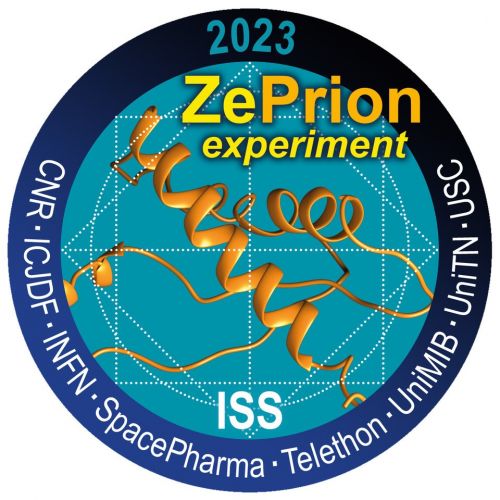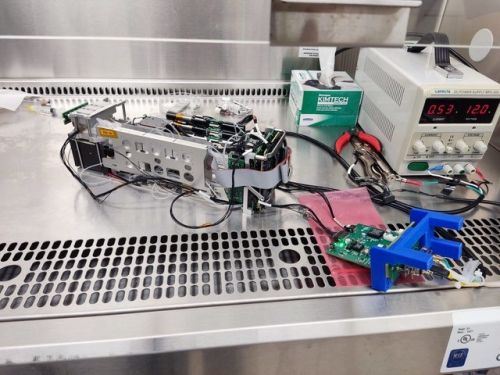- Press release (In Italian): Zeprion: in orbita per sviluppare nuovi farmaci. Consiglio Nazionale delle Ricerche. 2 August 2023
- Faccioli P. From quarks to drugs: a journey in technology transfer. Il nuovo saggiatore. VOL. 37, ANNO 2021, NO. 3-4.
The ZePrion experiment: set in space to fight diseases on earth
The experiment, sent to the ISS, looks into the molecular mechanism behind an innovative pharmaceutical protocol to combat prion diseases.
Translated from our original Italian version.
Into orbit to develop new drugs
A miniature biochemical laboratory, which arrived on 4 August 2023 on the International Space Station (ISS), could lead to the validation of the operating mechanism of a completely innovative protocol for the development of new drugs against serious neurodegenerative diseases, and perhaps more. This is the result of an international collaboration involving several academic institutes, the Israeli company SpacePharma, and the Telethon Foundation.
The ZePrion experiment took off with the NG-19 robotic space refuelling mission from the Wallops Island base in Virginia (USA). ZePrion aims to exploit the microgravity conditions present in the ICC orbit to test the possibility of inducing the destruction of specific proteins in the cell by interfering with their natural folding mechanism (protein folding).
The success of the ZePrion experiment would provide a possible way of confirming the molecular mechanism behind a new drug discovery technology called Pharmacological Protein Inactivation by Folding Intermediate Targeting (PPI-FIT), developed by two researchers from the Universities of Milan-Bicocca and Trento, and the Italian National Institute of Nuclear physics (Istituto Nazionale di Fisica Nucleare or INFN). The PPI-FIT approach is based on the identification of small molecules (called ligands) that are able to bind to the pharmacological target protein during its spontaneous folding process, thus preventing it from reaching its final form. The ability to block the folding of specific proteins involved in disease processes would pave the way for the development of new therapies for currently incurable diseases.
The PPI-FIT protocol
Whereas traditional pharmacology acts on proteins when this folding is complete, the PPI-FIT protocol allows action to be taken before the folding is complete, i.e. before the proteins have taken shape.
The idea behind this scheme is to look for small molecules capable of binding to pockets that are only present in transient folding intermediates, i.e. before the chain reaches its native state. In this way, the protein cannot proceed along the folding pathway and remains stuck in its intermediate. Cells are equipped with a quality control mechanism that enables them to efficiently recognise and eliminate partially or incorrectly folded proteins.
Therefore, by interrupting the folding process, cellular degradation of the target protein can be induced. This approach can be applied to virtually any target, but is particularly useful for proteins that cannot be destroyed by conventional methods.
The PPI-FIT approach was first validated on the human cellular prion protein (referred to here as PrPc). This polypeptide chain represents the substrate of infectious agents called prions, which consist of toxic aggregates of misfolded prion proteins, named PrPsc. Prions are responsible for several invariably fatal neurodegenerative diseases, including the infamous mad cow disease.
Like all misfolding diseases, prion-related diseases cannot be treated by conventional methods. On the other hand, by reducing the concentration of PrPc in the cells, it is in principle possible to hinder the growth and subsequent accumulation of toxic PrPsc aggregates, thus effectively hindering prion infection.
The experimental instruments (Credits: SpacePharma)
Finding answers in space
A missing piece in the validation of the technology so far is the possibility of obtaining a high-resolution image of the binding between the therapeutic small molecules and the intermediate forms of the target proteins (those that occur during folding), which can definitively confirm the disruption of the folding process itself. Typically, this type of image is obtained by analysing crystals, with a technique called X-ray crystallography, that are formed by the ligand-protein complex.
In the case of protein intermediates, however, the necessary experiments are not feasible within the laboratories on Earth, as gravity generates effects that interfere with the crystal formation of the corpuscles composed of ligand and protein, when the latter has not yet reached its final form. This prompted the researchers of the ZePrion collaboration to exploit the microgravity conditions that the International Space Station can provide.
Several recent studies have highlighted the considerable advantages of protein crystallisation under microgravity conditions. This is mainly due to the absence of convective motion, which on Earth can interfere with the formation of ordered crystals.
However, so far no experiment has attempted to generate crystals of protein-ligand complexes in which the protein is not in a final state. These crystals can then be analysed using X-ray radiation produced by particle accelerators to provide a three-dimensional photograph of the complex in atomic resolution detail. Non-crystalline samples obtained at SSI will also be analysed by Transmission Electron Cryo-microscopy (Cryo/EM).
In this experiment, the free-falling conditions that occur in orbit will be exploited to attempt the crystallisation of the PrPc protein, in conjunction with SM875, the small molecule discovered with the PPI-FIT approach. The protein will first be melted and then allowed to fold in the presence of the small molecule, which should then block the folding process by binding to its folding intermediate.
The ZePrion experiment will work specifically on the prion protein, which sadly made headlines in the 1990s during the 'mad cow disease' crisis. This disease is in fact caused by an altered form of the prion protein, which is involved in serious 'prion-like' neurodegenerative diseases such as Creutzfeld-Jakob disease (CJD) or fatal familial insomnia (FFI).
New perspectives on drug development
ZePrion consists of a real miniature biochemical laboratory (lab-in-a-box) made by Space Pharma, which will operate on board the International Space Station and is remotely controlled. The experimental apparatus consists of a miniaturised molecular biology laboratory that can be operated from Earth.
After the experiment, the samples will be brought back to Earth and structurally analysed. If this analysis confirms the formation of a good crystal, the sample will be sent to a synchrotron laboratory to be analysed with X-rays. Should this ambitious experiment be successful, it would open up a whole new avenue for drug research in space.

